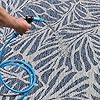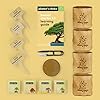Catchmaster Rat, Snake and Mouse Traps 10Pk, Large Bulk Glue Rat Traps for Home, Adhesive Plastic Tray for Inside House, Snake, Mice, & Spider Catcher, Pest Control for House & Garage
$22.49 ($2.25 / count) (as of December 28, 2025 01:54 GMT +00:00 - More infoProduct prices and availability are accurate as of the date/time indicated and are subject to change. Any price and availability information displayed on [relevant Amazon Site(s), as applicable] at the time of purchase will apply to the purchase of this product.)Keen Home Design Terrace Outdoor Area Rug - 8x10 Washable Indoor/Outdoor Rug for Patio, Kitchen, Balcony, Beach, Garden, Deck and Porch, Size: 7'7"x10'
$149.99 (as of December 28, 2025 01:09 GMT +00:00 - More infoProduct prices and availability are accurate as of the date/time indicated and are subject to change. Any price and availability information displayed on [relevant Amazon Site(s), as applicable] at the time of purchase will apply to the purchase of this product.)25 Best Houseplants for Cold Rooms and Low Light Conditions
Having plants in your home can brighten up any space and improve air quality. However, certain rooms like basements, bathrooms and offices can be challenging environments for houseplants due to cold temperatures and minimal natural light.
Not all plants thrive in dark, colder conditions. But there are plenty of houseplant varieties perfectly suited to surviving and growing in these areas.
This article explores the 25 best houseplants for cold rooms and low light levels, along with tips for caring for them properly.
Defining cold rooms and low light
When choosing the right houseplants, it’s important to understand what constitutes a cold room and low light conditions. Here are the key characteristics:
- Cold rooms – Temperatures consistently around 60°F or below. This includes basements, garages, bathrooms and offices in cooler climates.
- Low light – Light levels less than 25 to 50 foot candles. Low light rooms may have northern facing windows, heavy curtains/window treatments, or no windows at all. Artificial lighting alone is also considered low light.
Understanding your room’s typical temperature range and light exposure will help determine the best plants for those conditions.
Now, let’s explore 25 of the top houseplant varieties that can thrive in cold, low light environments.
Best Low-Light Houseplants for Cold Rooms
1. Golden Pothos

- Hanging vine with heart-shaped yellow and green leaves
- Tolerates a wide temperature range from 50°F to 85°F
- Low to bright indirect light
- Allow soil to dry out between waterings
With its trailing vines and variegated leaves, golden pothos is a great addition to shelves, counters or hanging planters. It handles both cold and low light with ease when kept away from drafts.
2. Chinese Evergreen

- Speckled oval leaves with shades of green and silver
- Prefers temperatures between 60°F and 75°F
- Low to medium indirect light
- Water weekly
An easy care option perfect for beginners, the Chinese evergreen thrives in indoor conditions with hardly any maintenance required. Just be sure to water regularly to keep soil slightly moist.
3. Peace Lily

- Dark green leaves with distinctive white flower spikes
- Tolerates temperatures from 60°F to 80°F
- Low to medium light
- Allow soil to partly dry out between watering
Featuring lush leaves and beautiful flowers, the peace lily offers visual appeal. It handles colder conditions well as long as it’s not placed in direct sunlight or drafty areas.
4. Cast Iron Plant

- Oblong deep green leaves emerging from the soil
- Tolerates temperatures down to 50°F
- Low to bright indirect light
- Allow soil to partly dry out between watering
The cast iron plant is practically indestructible and stays lush and vibrant even in frigid indoor environments with minimal light. An easy houseplant anyone can grow successfully.
5. Snake Plant

- Stiff spiky leaves with yellow edges
- Tolerates temperatures between 55°F and 80°F
- Low to bright indirect light
- Thrives on occasional watering
Also known as mother-in-law’s tongue, the snake plant requires hardly any maintenance and sustains itself in dark cold spots. Let the soil dry out completely between waterings.
6. ZZ Plant

- Glossy oval leaves growing on thick stems
- Tolerates temperatures between 60°F and 80°F
- Low to medium indirect light
- Water every 2-3 weeks
The ZZ plant remains unfazed by cold dry air and low light conditions inside. Just be cautious of overwatering, as it prefers drier soil.
7. Norfolk Island Pine

- Mini tropical pine tree with soft fern-like leaves
- Tolerates temperatures between 55°F and 70°F
- Low to medium indirect light
- Water weekly
This petite evergreen tree brings the look of an outdoor pine inside, with none of the hassle. It adapts well to low light rooms and colder temperatures.
8. Bamboo Palm
- Feathery frond leaves on woody stems
- Tolerates temperatures between 55°F and 80°F
- Low to medium indirect light
- Water weekly
Also known as reed palm, the bamboo palm handles dark corners and dropping temps with proper care. Mist the leaves occasionally since colder air can dry plants out.
9. Dracaena

- Spiky strappy leaves, often variegated
- Tolerates temperatures between 65°F and 80°F
- Low to medium light
- Allow soil dry out somewhat between watering
Dracaena offers vivid foliage colors like purple, green and yellow for a burst of interest. Keep away from drafts and windows for the best growth in basements or offices.
10. Ponytail Palm

- Curly palm stems with bulbous base
- Tolerates temperatures between 45°F and 80°F
- Low to medium light
- Allow soil to partly dry out between watering
Despite its name, the ponytail palm is actually a succulent that can handle cold and low light levels with proper care. Just avoid overwatering.
11. Pothos

- Heart-shaped leaves trailing on vines
- Tolerates temperatures between 60°F and 85°F
- Low to medium light
- Allow soil to partly dry out between watering
With its iconic dangling vines and green heart-shaped leaves, pothos is one of the most popular houseplants for any condition. Cold low-light rooms are no match for this hardy grower.
12. Ferns
- Delicate, lacy leaves
- Tolerate temperatures between 60°F and 75°F
- Low to medium indirect light
- Keep soil consistently moist
Bost Here are some more of the best houseplants for cold, low light rooms:
13. Peperomia

- Round, succulent-like leaves in a variety of colors
- Tolerates temperatures between 55°F and 80°F
- Low to medium indirect light
- Allow soil to partly dry out between waterings
With over 1000 varieties, peperomia offers diverse options like the Watermelon Peperomia. As a succulent, peperomia stores water in its thick leaves for adaptability.
14. Prayer Plant

- Distinctive green leaves with purple undersides
- Tolerates temperatures between 60°F and 80°F
- Low to medium indirect light
- Keep soil consistently moist
Named for its unique nighttime leaf movements, the prayer plant is a good option for darker corners yet doesn’t tolerate cold drafts well.
15. Dieffenbachia

- Oval leaves with cream & green variegation
- Tolerates temperatures between 60°F and 80°F
- Low to medium indirect light
- Water weekly
Dieffenbachia provides great dimensional leaves and patterns for visual interest. Keep soil moist and mist leaves regularly in dry air.
16. Philodendrons
- Trailing split leaves in heart and oval shapes
- Tolerate temperatures between 65°F and 80°F
- Low to medium indirect light
- Allow soil to partly dry out between waterings
Philodendrons are fast growing and adapt readily to lower light and cooler temps. Prune when needed to keep its trailing vines tidy.
17. Rex Begonia
- Colorful ornate leaves with variegation
- Tolerates temperatures between 60°F and 80°F
- Low to medium indirect light
- Keep soil consistently moist
Rex begonias offer unique curled foliage with vivid colors and patterns that brighten up any shady corner. Provide ample humidity.
18. Parlor Palm

- Clustering green frond leaves on thin stems
- Tolerates temperatures between 55°F and 80°F
- Low to medium indirect light
- Water weekly
The parlor palm is a sturdy choice that handles being moved around and adapts to any indoor conditions, including cold and low light rooms.
19. Calathea

- Large oval leaves with colorful patterns
- Tolerates temperatures between 65°F and 80°F
- Low to medium indirect light
- Keep soil consistently moist
The eye-catching patterns and designs on calathea leaves add visual interest. Provide regular watering and keep away from cold drafts.
20. Bird’s Nest Fern
- Large drooping leaves emerging from central fronds
- Tolerates temperatures between 60°F and 75°F
- Medium to low indirect light
- Keep soil consistently moist
The bird’s nest fern’s cascading leaves make a statement. Keep away from AC vents and heating units to thrive.
21. Nerve Plant
- Green leaves with bright pink, yellow or white veins
- Tolerates temperatures between 65°F and 85°F
- Low to medium indirect light
- Evenly moist soil
If you want a pop of color, nerve plant’s vibrant veined leaves shine in dark rooms. Avoid direct light, which causes leaves to fade.
22. Monsteras

- Large, hole-filled leaves on climbing stems
- Tolerates temperatures between 65°F and 85°F
- Low to medium indirect light
- Allow soil to partly dry out between waterings
Monsteras thrive as houseplants and their aerial roots love climbing and clinging to surfaces. Their large leaves bring drama.
23. Aglaonema
- Patterned leaves with silver/gray and dark green hues
- Tolerates temperatures between 60°F and 85°F
- Low to medium indirect light
- Water weekly
The eye-catching patterns and colors of Agalonemas like the Chinese Evergreen make them perfectly suited for dim corners and rooms.
24. Dracaena Warneckii

- Ribbon-like leaves with white and green bands
- Tolerates temperatures between 65°F and 75°F
- Low to medium indirect light
- Water weekly
Also known as Warneck dracaena, its slender leaves offer vertical interest in any space. Keep away from drafts.
25. Ficus Elastica

- Thick, waxy green leaves on woody stems
- Tolerates temperatures between 55°F and 65°F
- Low to medium indirect light
- Allow soil to partly dry out between waterings
The Ficus Elastica, or rubber plant, handles cold temperatures and minimal light while helping filter indoor air. Slow growing and low maintenance!
Growing Tips for Cold, Low Light Rooms
Choosing plants suited to the room’s environment is key, but you can also optimize conditions to help houseplants in cold and low light thrive:
- Maintain temperatures between 60°F to 80°F whenever possible.
- Move plants away from drafty windows, vents, and excessive heat sources.
- Use a humidifier during dry winter months to increase moisture.
- Ensure plants receive ambient indoor light from lamps, overhead lights or shaded windows if possible.
- Rotate plants weekly so all sides get light exposure.
- Dust leaves regularly so plants can soak up any available light.
- Use lamps or grow lights to supplement minimal natural light sources.
- Propagate new plants from healthy parent plants accustomed to the room’s conditions.
- Avoid overwatering; only water when soil is partly dry.
By selecting suitable varieties and providing optimal care, your plants can readily adapt and flourish in the cold, low light environment!




























